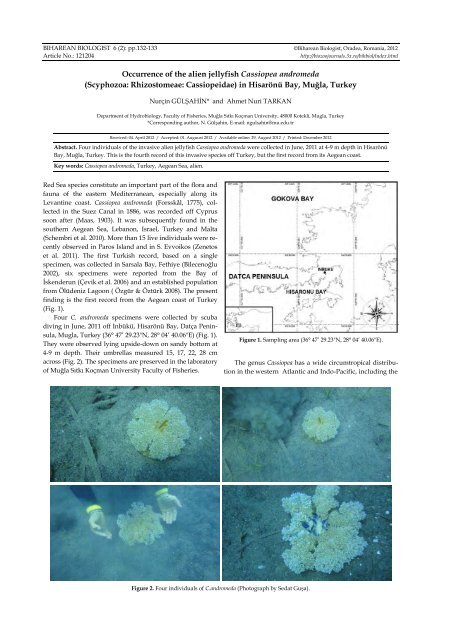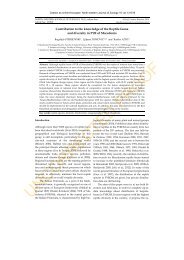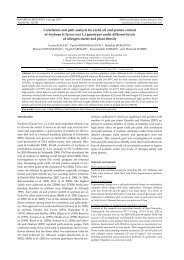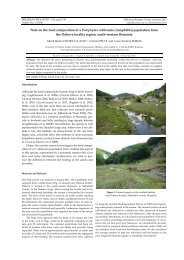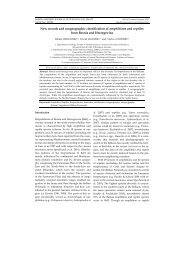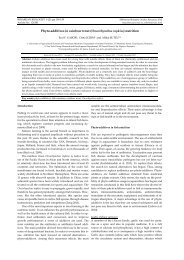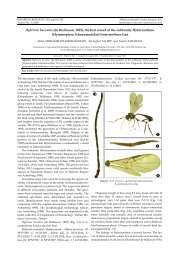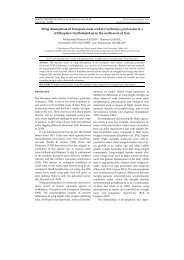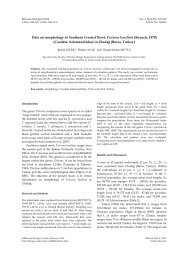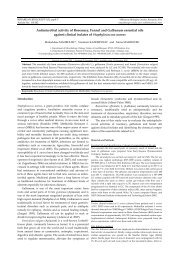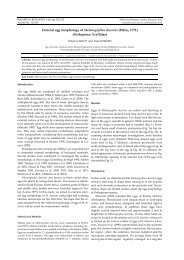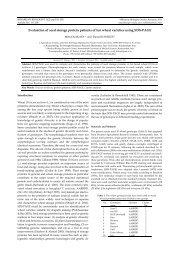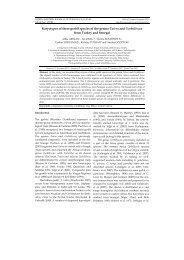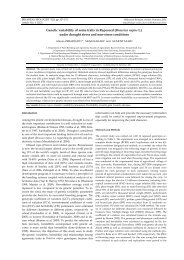Scyphozoa: Rhizostomeae: Cassiopeidae - 3X.ro
Scyphozoa: Rhizostomeae: Cassiopeidae - 3X.ro
Scyphozoa: Rhizostomeae: Cassiopeidae - 3X.ro
Create successful ePaper yourself
Turn your PDF publications into a flip-book with our unique Google optimized e-Paper software.
BIHAREAN BIOLOGIST 6 (2): pp.132-133 ©Biharean Biologist, Oradea, Romania, 2012<br />
Article No.: 121204 http://biozoojournals.3x.<strong>ro</strong>/bihbiol/index.html<br />
Occurrence of the alien jellyfish Cassiopea and<strong>ro</strong>meda<br />
(<st<strong>ro</strong>ng>Scyphozoa</st<strong>ro</strong>ng>: <st<strong>ro</strong>ng>Rhizostomeae</st<strong>ro</strong>ng>: <st<strong>ro</strong>ng>Cassiopeidae</st<strong>ro</strong>ng>) in Hisarönü Bay, Muğla, Turkey<br />
Nurçin GÜLŞAHİN* and Ahmet Nuri TARKAN<br />
Department of Hyd<strong>ro</strong>biology, Faculty of Fisheries, Muğla Sıtkı Koçman University, 48000 Kotekli, Mugla, Turkey<br />
*Corresponding author, N. Gülşahin, E-mail: ngulsahin@mu.edu.tr<br />
Received: 04. April 2012 / Accepted: 01. Auguust 2012 / Available online: 29. August 2012 / Printed: December 2012<br />
Abstract. Four individuals of the invasive alien jellyfish Cassiopea and<strong>ro</strong>meda were collected in June, 2011 at 4-9 m depth in Hisarönü<br />
Bay, Muğla, Turkey. This is the fourth record of this invasive species off Turkey, but the first record f<strong>ro</strong>m its Aegean coast.<br />
Key words: Cassiopea and<strong>ro</strong>meda, Turkey, Aegean Sea, alien.<br />
Red Sea species constitute an important part of the flora and<br />
fauna of the eastern Mediterranean, especially along its<br />
Levantine coast. Cassiopea and<strong>ro</strong>meda (Forsskål, 1775), collected<br />
in the Suez Canal in 1886, was recorded off Cyprus<br />
soon after (Maas, 1903). It was subsequently found in the<br />
southern Aegean Sea, Lebanon, Israel, Turkey and Malta<br />
(Schembri et al. 2010). More than 15 live individuals were recently<br />
observed in Pa<strong>ro</strong>s Island and in S. Evvoikos (Zenetos<br />
et al. 2011). The first Turkish record, based on a single<br />
specimen, was collected in Sarsala Bay, Fethiye (Bilecenoğlu<br />
2002), six specimens were reported f<strong>ro</strong>m the Bay of<br />
İskenderun (Çevik et al. 2006) and an established population<br />
f<strong>ro</strong>m Ölüdeniz Lagoon ( Özgür & Öztürk 2008). The present<br />
finding is the first record f<strong>ro</strong>m the Aegean coast of Turkey<br />
(Fig. 1).<br />
Four C. and<strong>ro</strong>meda specimens were collected by scuba<br />
diving in June, 2011 off Inbükü, Hisarönü Bay, Datça Peninsula,<br />
Mugla, Turkey (36° 47’ 29.23"N, 28° 04’ 40.06"E) (Fig. 1).<br />
They were observed lying upside-down on sandy bottom at<br />
4-9 m depth. Their umbrellas measured 15, 17, 22, 28 cm<br />
ac<strong>ro</strong>ss (Fig. 2). The specimens are preserved in the laboratory<br />
of Muğla Sıtkı Koçman University Faculty of Fisheries.<br />
Figure 1. Sampling area (36° 47’ 29.23"N, 28° 04’ 40.06"E).<br />
The genus Cassiopea has a wide circumt<strong>ro</strong>pical distribution<br />
in the western Atlantic and Indo-Pacific, including the<br />
Figure 2. Four individuals of C.and<strong>ro</strong>meda (Photograph by Sedat Guşa).
Occurrence of Cassiopea and<strong>ro</strong>meda in Muğla<br />
Red Sea. Cassiopea and<strong>ro</strong>meda is well established in the<br />
Levantine and Aegean Seas, with an interesting record f<strong>ro</strong>m<br />
the central Mediterranean (Schembri et al. 2010). Though<br />
hitherto unknown f<strong>ro</strong>m the southern Aegean coast of Turkey,<br />
this record fills in the gap.<br />
Acknowledgements. We thank the scuba divers Sedat GUŞA, Ali<br />
Osman ERNALBANT, Mesut AKALP, Emre Yunus TAMAÇ, Ali<br />
Serkan AVCI. Also, we want to thank Dr. Halit FİLİZ and Dr.<br />
Gökçen BİLGE for their helps in preparing this manuscript.<br />
References<br />
Bilecenoğlu, M. (2002): Türkiye kıyılarında ilk kez rastlanan bir denizanası<br />
türü: Cassiopea and<strong>ro</strong>meda (Forsskal, 1775) (<st<strong>ro</strong>ng>Cassiopeidae</st<strong>ro</strong>ng>, <st<strong>ro</strong>ng>Scyphozoa</st<strong>ro</strong>ng>). Journal<br />
of Underwater World 72: 42-43.<br />
Çevik, C., Erkol, I.L., Toklu, B. (2006): A new record of an alien jellyfish f<strong>ro</strong>m<br />
the Levantine coast of Turkey—Cassiopea and<strong>ro</strong>meda (Forsskål, 1775)<br />
[Cnidaria: <st<strong>ro</strong>ng>Scyphozoa</st<strong>ro</strong>ng>: Rhizostomea]. Aquatic Invasions 1: 196–197.<br />
Galil, B.S., Spanier, E., Ferguson, W.W. (1990): The scyphomedusae of the<br />
Mediterranean coast of Israel, including two Lessepsian migrants new to the<br />
Mediterranean. Zoologische Mededelingen (Leiden) 64: 95–105.<br />
Goy, J., Lakkis, S., Zeidane, R. (1988): Les Méduses de la Méditerranée<br />
Orientale. Rapports et P<strong>ro</strong>cès –Verbaux des Réunions. Commission<br />
Internationale pour l’Exploration Scientifique de la Mer Méditerraneé 31(2):<br />
299.<br />
133<br />
Maas, O. (1903): Die Scyphomedusen der Siboga-expedition [Siboga-expeditie<br />
11.] Leiden: E.J. Brill; viii + 91 pp. + plates I–XII.<br />
Özgür, E., Öztürk, B. (2008): A population of the alien jellyfish, Cassiopea<br />
and<strong>ro</strong>meda (Forsskål, 1775) [Cnidaria: <st<strong>ro</strong>ng>Scyphozoa</st<strong>ro</strong>ng>: Rhizostomea] in the<br />
Ölüdeniz Lagoon, Turkey Aquatic Invasions 3(4): 423-428.<br />
Schäffer, W. (1955): Eine Qualle aus dem Indischen Ozean in der Agais. – Natur<br />
Volk 85: 241-245.<br />
Schembri, P.J., Deidun, A., Vella, P.J. (2010): First record of Cassiopea and<strong>ro</strong>meda<br />
(<st<strong>ro</strong>ng>Scyphozoa</st<strong>ro</strong>ng>: <st<strong>ro</strong>ng>Rhizostomeae</st<strong>ro</strong>ng>: <st<strong>ro</strong>ng>Cassiopeidae</st<strong>ro</strong>ng>) f<strong>ro</strong>m the central Mediterranean<br />
Sea. Marine Biodiversity Records 3: e6.<br />
Spanier, E. (1989): Swarming of jellyfishes along the Mediterranean cost of<br />
Israel. Israel Journal of Zoology 36(1): 55-56.<br />
Turan, C., Özbalcılar, B., Ergüden, D., Uygur, N. (2011): Occurence and<br />
abundance of lessepsian jellyfish Cassiopea and<strong>ro</strong>meda (Forsskål, 1775) in<br />
İskenderun Bay, the Northeastern Mediterranean Sea First National<br />
Workshop on Jellyfish and Other Gelatinous Species in Turkish Marine<br />
Waters. Published by Turkish Marine Research Foundation, Istanbul,<br />
Turkey, No:35, p.73-77.<br />
Verde, E.A., McCloskey, L.R. (1998): P<strong>ro</strong>duction, respiration, and<br />
photophysiology of the mang<strong>ro</strong>ve jellyfish Cassiopea xamachana symbiotic<br />
with zooxanthellae: effect of jellyfish size and season. Marine Ecology<br />
P<strong>ro</strong>gress Series 168: 147–162.<br />
Zenetos, A., Katsanevakis, S., Poursanidis, D., C<strong>ro</strong>cetta, F., Damalas, D.,<br />
Apostolopoulos, G., Gravili, C., Vardala-Theodo<strong>ro</strong>u, E., Malaquias, M.<br />
(2011): Marine alien species in Greek Seas: Additions and amendments by<br />
2010. Mediterranean Marine Science 12(1): 95-120.


